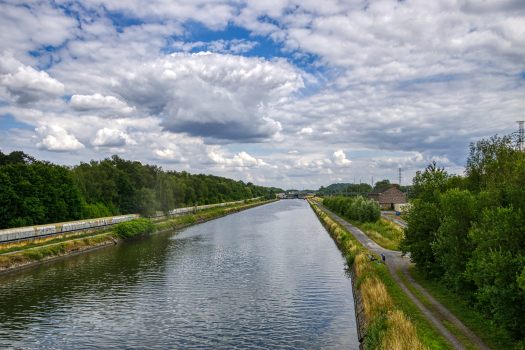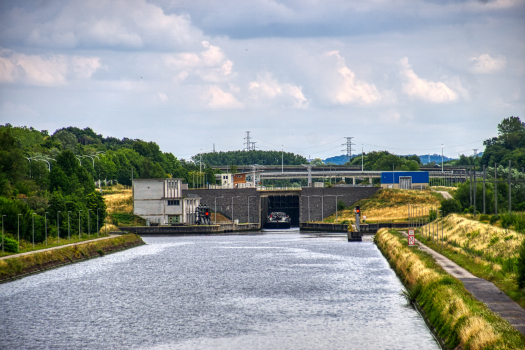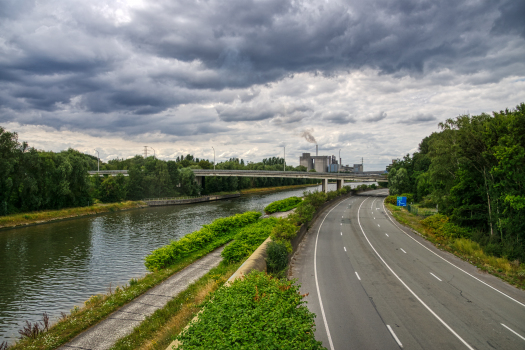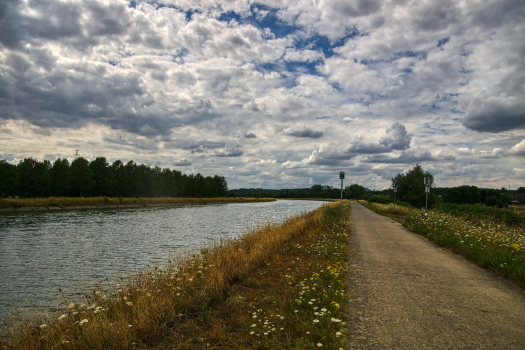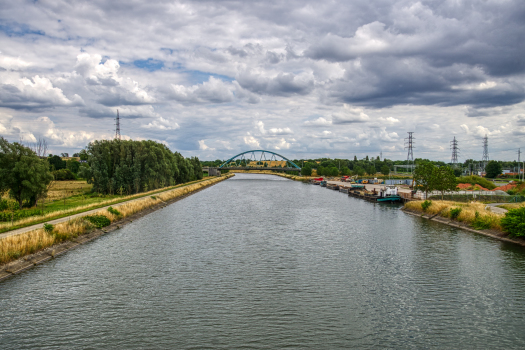General Information
Project Type
| Function / usage: |
Canal |
|---|
Location
| km | Name |
| 114.660 |
Technical Information
There currently is no technical data available.
Excerpt from Wikipedia
The Canal du Centre is a canal in Belgium, which, with other canals, links the waterways of the Meuse and Scheldt rivers. It has a total length of 20.9 km (13.0 miles). It connects the artificial lake Grand Large near Nimy, with the Brussels–Charleroi Canal near Seneffe.
Route
The canal begins in the west at Mons, and passes through the towns of Nimy, Obourg, Ville-sur-Haine, and Thieu. This section is 15 km (9.3 miles) long, and has a relief of 23.26 metres (76.3 feet). The canal climbs by means of six locks. There are five locks with a relief of 4.2 m (14 feet), and a final lock with a relief of 2.26 m (7 ft 5 in) at Thieu.
The next section of the original canal route between Thieu and Houdeng-Gœgnies climbs 66 metres (217 feet) over a distance of 6,790 m (22,280 feet), which is too steep a climb for canal locks. Therefore, this section contains four hydraulic boat lifts, dating from 1888 to 1917, which are now on the UNESCO World Heritage list (see Boat Lifts on the Canal du Centre). These lifts were designed by Edwin Clark of the British company Clark, Stansfield & Clark. For commercial traffic this stretch of the canal has, since 2002, been replaced by an enlarged parallel canal.
History
Old canal
For centuries, Belgian people have wanted an inland waterway to connect the Meuse and the Scheldt. However, the height difference of about 96 metres (315 ft) between the two rivers would require as many as 32 locks, which was not feasible. In 1879, the Ministry of Public Works adopted a proposal by Edwin Clark which used boat lifts instead of locks. The first lift (Houdeng-Gœgnies) was built between 1885 and 1888. It was inaugurated on June 4, 1888 by King Leopold II. The three other boat lifts were finally finished in 1917 and put into service in 1919. There were several reasons for this delay. From 1894 to 1911, the economic need for the canal was repeatedly called into question. Then in 1914, when the three lifts were practically finished, World War I began.
New canal
The old canal could accommodate boats with a displacement of up to 350 tons.[ ambiguous] In 1957 the Belgian parliament passed a law providing for a major expansion of the canal, increasing the maximum displacement of a boat that could use the canal to 1,350 tonnes (1,490 tons). In the event, it was decided to alter the course of the canal rather than to enlarge it along the full extent of ist existing length. A defining feature of the enlarged canal was the Strépy-Thieu boat lift which replaced the four smaller boat lifts and one or two locks which had been part of the former canal.
The Canal du Centre was opened to boats with a displacement of 1,350 tonnes in September 2002. Between 2000 and 2004 the annual ship transits increased from 1,531 to 4,041 while the tonnage carried increased from 282,000 to 1,513,000.
The lifts on the old parallel canal remain in position, having in 1998 been designated a UNESCO World Heritage Site.
Text imported from Wikipedia article "Canal du Centre (Belgium)" and modified on June 4, 2020 according to the CC-BY-SA 4.0 International license.
Participants
Currently there is no information available about persons or companies having participated in this project.
Relevant Web Sites
Relevant Publications
- L'ascenseur à bâteaux de Strépy-Thieu. brochure, ir Benedictus Faes, Namur (Belgium), 2002.
- (2016): Le Canal du Centre historique et ses ponts. In: (2016): Ponts métalliques belges. ICOMOS Wallonie-Bruxelles, Brussels (Belgium), ISBN 978-2-9600205-6-4, pp. 44-51.
- About this
data sheet - Structure-ID
10000355 - Published on:
08/08/2003 - Last updated on:
05/08/2022



